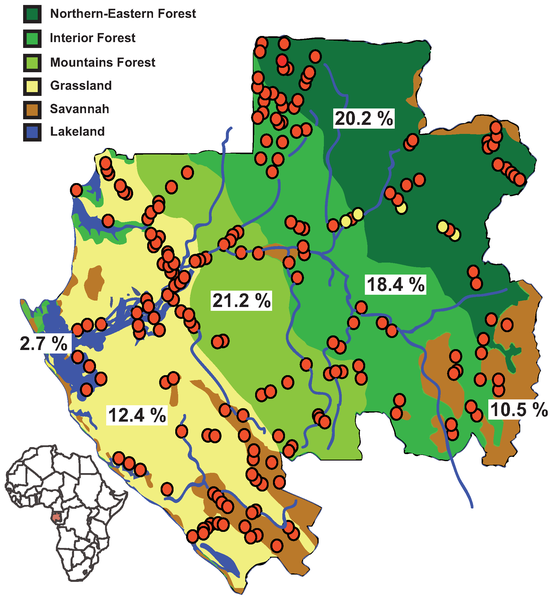High Prevalence of Both Humoral and Cellular Immunity to Zaire ebola virus among Rural Populations in Gabon
http://www.plosone.org/article/info%3Adoi%2F10.1371%2Fjournal.pone.0009126
Pierre Becquart<sup>1</sup><sup>,</sup><sup>2</sup><sup>#</sup>, Nadia Wauquier<sup>1</sup><sup>#</sup>, Tanel Mahlakõiv<sup>1</sup>, Dieudonné Nkoghe<sup>1</sup>, Cindy Padilla<sup>1</sup>, Marc Souris<sup>2</sup><sup>,</sup><sup>3</sup>, Benjamin Ollomo<sup>1</sup>, Jean-Paul Gonzalez<sup>1</sup>, Xavier De Lamballerie<sup>2</sup>, Mirdad Kazanji<sup>1</sup>, Eric M. Leroy<sup>1</sup><sup>,</sup><sup>2</sup><sup>*</sup>
1 Unité des Maladies Virales Emergentes, Centre International de Recherches Médicales de Franceville, Franceville, Gabon, 2 UMR190 Emergence des Pathologies Virales, Université Aix-Marseille II & Institut de Recherche pour le Développement, Marseille, France, 3 Mahidol University at Salaya, Nakhonpathon, Thailand
free full text
Abstract
To better understand Zaire ebolavirus (ZEBOV) circulation and transmission to humans, we conducted a large serological survey of rural populations in Gabon, a country characterized by both epidemic and non epidemic regions. The survey lasted three years and covered 4,349 individuals from 220 randomly selected villages, representing 10.7% of all villages in Gabon. Using a sensitive and specific ELISA method, we found a ZEBOV-specific IgG seroprevalence of 15.3% overall, the highest ever reported. The seroprevalence rate was significantly higher in forested areas (19.4%) than in other ecosystems, namely grassland (12.4%), savannah (10.5%), and lakeland (2.7%). No other risk factors for seropositivity were found. The specificity of anti-ZEBOV IgG was confirmed by Western blot in 138 individuals, and CD8 T cells from seven IgG+ individuals were shown to produce IFN-γ after ZEBOV stimulation. Together, these findings show that a large fraction of the human population living in forested areas of Gabon has both humoral and cellular immunity to ZEBOV. In the absence of identified risk factors, the high prevalence of “immune” persons suggests a common source of human exposure such as fruits contaminated by bat saliva. These findings provide significant new insights into ZEBOV circulation and human exposure, and raise important questions as to the human pathogenicity of ZEBOV and the existence of natural protective immunization.

Figure 1. Map of Gabonese villages (red circles) included in the survey, according to the ecological region.
Villages where children <16 years were specifically included in the study are indicated by yellow circles. The overall prevalence of ZEBOV-specific IgG in each ecological region is shown.
http://www.plosone.org/article/info%3Adoi%2F10.1371%2Fjournal.pone.0009126
Pierre Becquart<sup>1</sup><sup>,</sup><sup>2</sup><sup>#</sup>, Nadia Wauquier<sup>1</sup><sup>#</sup>, Tanel Mahlakõiv<sup>1</sup>, Dieudonné Nkoghe<sup>1</sup>, Cindy Padilla<sup>1</sup>, Marc Souris<sup>2</sup><sup>,</sup><sup>3</sup>, Benjamin Ollomo<sup>1</sup>, Jean-Paul Gonzalez<sup>1</sup>, Xavier De Lamballerie<sup>2</sup>, Mirdad Kazanji<sup>1</sup>, Eric M. Leroy<sup>1</sup><sup>,</sup><sup>2</sup><sup>*</sup>
1 Unité des Maladies Virales Emergentes, Centre International de Recherches Médicales de Franceville, Franceville, Gabon, 2 UMR190 Emergence des Pathologies Virales, Université Aix-Marseille II & Institut de Recherche pour le Développement, Marseille, France, 3 Mahidol University at Salaya, Nakhonpathon, Thailand
free full text
Abstract
To better understand Zaire ebolavirus (ZEBOV) circulation and transmission to humans, we conducted a large serological survey of rural populations in Gabon, a country characterized by both epidemic and non epidemic regions. The survey lasted three years and covered 4,349 individuals from 220 randomly selected villages, representing 10.7% of all villages in Gabon. Using a sensitive and specific ELISA method, we found a ZEBOV-specific IgG seroprevalence of 15.3% overall, the highest ever reported. The seroprevalence rate was significantly higher in forested areas (19.4%) than in other ecosystems, namely grassland (12.4%), savannah (10.5%), and lakeland (2.7%). No other risk factors for seropositivity were found. The specificity of anti-ZEBOV IgG was confirmed by Western blot in 138 individuals, and CD8 T cells from seven IgG+ individuals were shown to produce IFN-γ after ZEBOV stimulation. Together, these findings show that a large fraction of the human population living in forested areas of Gabon has both humoral and cellular immunity to ZEBOV. In the absence of identified risk factors, the high prevalence of “immune” persons suggests a common source of human exposure such as fruits contaminated by bat saliva. These findings provide significant new insights into ZEBOV circulation and human exposure, and raise important questions as to the human pathogenicity of ZEBOV and the existence of natural protective immunization.
Figure 1. Map of Gabonese villages (red circles) included in the survey, according to the ecological region.
Villages where children <16 years were specifically included in the study are indicated by yellow circles. The overall prevalence of ZEBOV-specific IgG in each ecological region is shown.